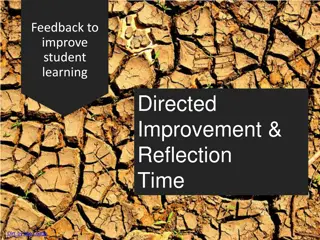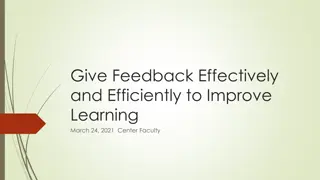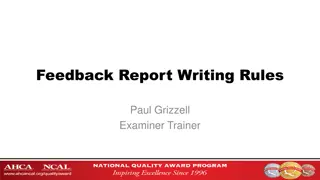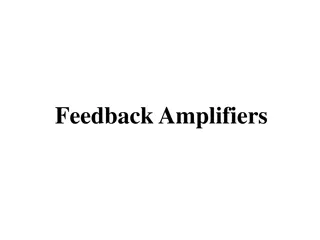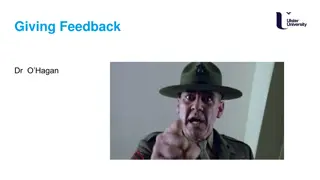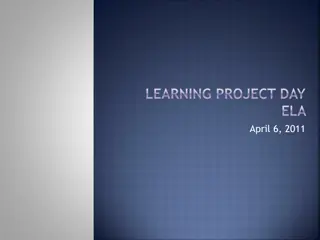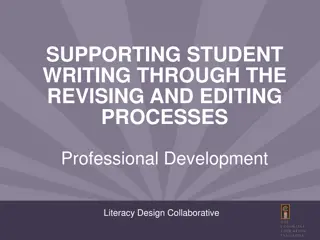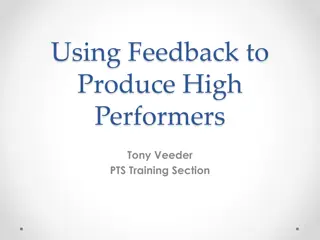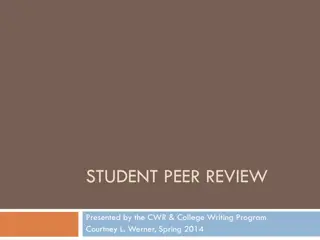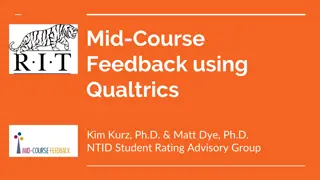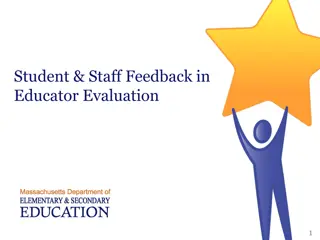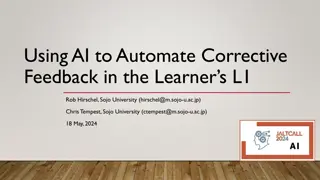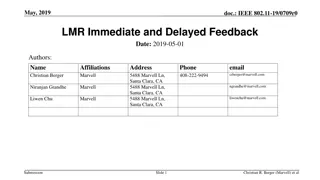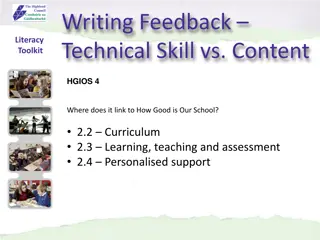Enhancing Student Writing: Effective Feedback Strategies
Enhance student writing through effective feedback strategies sponsored by the Writing Across the Curriculum Program at San Jose State University. The feedback process is viewed as an opportunity to teach, emphasizing strengths, weaknesses, and improvement areas for students. Designing clear instructions, rubrics, and assignments is key to promoting student success. The importance of identifying strengths and weaknesses in feedback is highlighted, guiding students on what to replicate and improve.
Download Presentation

Please find below an Image/Link to download the presentation.
The content on the website is provided AS IS for your information and personal use only. It may not be sold, licensed, or shared on other websites without obtaining consent from the author. Download presentation by click this link. If you encounter any issues during the download, it is possible that the publisher has removed the file from their server.
E N D
Presentation Transcript
PROVIDING FEEDBACK ON STUDENT WRITING Sponsored by the Writing Across the Curriculum Program San Jose State University Sara Cook
AGENDA 1. Feedforward: Designing Effective Materials 2. The Tenets of Effective Feedback 3. In-text Marks + Comments 4. Culminating Comments + Rubric
To communicate how the student can improve by detailing his/her/their strengths and weaknesses. THE GOAL OF PROVIDING FEEDBACK Consider the feedback process an opportunity to teach (vs. substantiate a grade).
DESIGNING EFFECTIVE MATERIALS Clear instructions Rubric Modeling Skills Scaffolding* Set them (and you) up for success with clear, well- developed materials and scaffolding. *Helps prevent AI use
DESIGNING EFFECTIVE MATERIALS ASSIGNMENTS Basic Requirements: Due dates, length, etc. Context: Learning goals, real life, etc. Rhetorical Specifications: Purpose, Audience, Genre. Prompt: Accounts for classroom context, appropriate scope, etc.
DESIGNING EFFECTIVE MATERIALS ASSIGNMENTS RUBRICS Basic Requirements: Due dates, length, etc. Context: Learning goals, real life, etc. Rhetorical Specifications: Purpose, Audience, Genre. Prompt: Accounts for classroom context, appropriate scope, etc. Specifying the assessment criteria for them AND you. Narrative, Numeric, Analytic, and Holistic Criteria: Content and Prose Diction: Employ the same diction in the rubric and the prompt: the student must see how these two documents take root in each other.
THE TENETS OF EFFECTIVE FEEDBACK
THE TENETS OF EFFECTIVE FEEDBACK 1. Identify both strengths and weaknesses Students need to know what to replicate, as well as what to repair.
THE TENETS OF EFFECTIVE FEEDBACK 2. Criticize both Content and Prose Content Prose GE Guidelines, Assessment: Writing shall be assessed for Strengths Strengths grammar, clarity, conciseness and coherence. Weaknesses Weaknesses
THE TENETS OF EFFECTIVE FEEDBACK 3. Quantity Matters Too little feedback = Makes it very difficult for students to improve (and not make the Same mistakes again.)
THE TENETS OF EFFECTIVE FEEDBACK 3. Quantity Matters Too little feedback = Makes it very difficult for students to improve (and not make the Same mistakes again.)
THE TENETS OF EFFECTIVE FEEDBACK 3. Quantity Matters Too much feedback = The volume of marks/comments can overwhelm students (especially now).
THE TENETS OF EFFECTIVE FEEDBACK 3. Quantity Matters Too much feedback = The volume of marks/comments can overwhelm students (especially now). Students are not given the opportunity to find and correct errors themselves.
THE TENETS OF EFFECTIVE FEEDBACK 3. Quantity Matters Too much feedback = The volume of marks/comments can overwhelm students (especially now). Students are not given the opportunity to find and correct errors themselves. Instructors may burn-out, or sacrifice future assessments.
THE TENETS OF EFFECTIVE FEEDBACK 4. Mark Patterns Students often repeat; errors or weaknesses throughout an assignment. Whenever possible; identify these patterns for the student. Focus on the errors or weaknesses; that most undermine the clarity and readability of the piece. (What is the pattern of error in this slide?)
THE TENETS OF EFFECTIVE FEEDBACK 5. Actionable + Specific Consider these common feedback phrases: Good work! This is a weak paper.
THE TENETS OF EFFECTIVE FEEDBACK 5. Actionable + Specific Consider these common feedback phrases: Good work! This is a weak paper. These are not actionable, or specific. These are value judgements. What, exactly, is good ? What, exactly, is weak ?
THE TENETS OF EFFECTIVE FEEDBACK 5. Actionable + Specific If you favor phrases like these, consider adding a colon after each statement of value. "Good work: Your sentence construction is more strategic in this paper than in the last one, which has yielded more meaningful prose.
THE TENETS OF EFFECTIVE FEEDBACK 5. Actionable + Specific If you favor phrases like these, consider adding a colon after each statement of value. "Good work: Your sentence construction is more strategic in this paper than in the last one, which has yielded more meaningful prose. "This is a weak paper: Your thesis only addresses the prompt superficially, and in the second paragraph you propose a different thesis; following this, you do not offer any evidence to support your claims, just beliefs."
THE TENETS OF EFFECTIVE FEEDBACK 5. Actionable + Specific Consider familiarizing yourself with the Top 20 Errors in Undergraduate Writing This helps us avoid comments like awkward that are not actionable or specific, and usually just exist to substantiate a grade.
THE TENETS OF EFFECTIVE FEEDBACK 5. Actionable + Specific The most ubiquitous form of evaluation, grading, is so much a part of the school landscape that we easily overlook its utter uselessness as actionable feedback. Grades are here to stay, no doubt but that doesn't mean we should rely on them as a major source of feedback. - Grant Wiggins
IN A NUTSHELL Balance: Strengths & Weaknesses Content & Prose Enough feedback, but not too much
IN A NUTSHELL Balance: Identify: Patterns of error, and/or what problem/s are doing the most damage. Strengths & Weaknesses Content & Prose Provide: Enough feedback, but not too much Specific, actionable feedback.
IN-TEXT FEEDBACK What do we mark, and how do we mark it?
GET PREPARED Review the prompt and rubric. Think about what skills, knowledge, and learning goals students need to demonstrate in the assignment. What is most important?
IN-TEXT FEEDBACK 1. Triage Start by reading the entire assignment WITHOUT marking anything. Sit on your hands if you have to. Or, preview 4-5 papers and see if any patterns emerge.
IN-TEXT FEEDBACK 1. Triage Next Given the rhetorical context and learning objectives of the assignment, what issues are most undermining the text? What issues most deserve your time and attention?
IN-TEXT FEEDBACK 1. Triage A triage helps save time, and focus the feedback. This allows instructors to find patterns, and decide which battles they are going to fight (ultimately saving time). Battles can be local/sectional/global.
IN-TEXT FEEDBACK 1. Triage This also enables instructors to find (if applicable) one paragraph, or one page, that comprehensively demonstrates the systemic issues in the text. Then, the instructor can thoroughly mark-up only that one paragraph, or page. A triage helps save time, and focus the feedback This allows instructors to find patterns, and decide which battles they are going to fight (ultimately saving time). Battles can be local/sectional/global.
IN-TEXT FEEDBACK 2. WHAT to Mark Whenever possible, mark patterns of error or weakness. Content: Tackle the problem/s that are preventing the student from achieving the purpose of the assignment and/or learning goals, or whatever problem is doing the most damage. Prose: Tackle the problem/s that most interfere with meaning, and/or readability.
IN-TEXT FEEDBACK 3. HOW to Mark: the 4-Step Strategy 1. Indicate, name, and correct the first occurrence in the pattern. Responsibility: Instructor 2. Indicate and name the second occurrence in the pattern. Responsibility: Instructor & student 3. Indicate the third occurrence in the pattern. Responsibility: Instructor & student 4. Leave some errors completely unmarked. Responsibility: Student
IN-TEXT FEEDBACK Why is it so important to name the error or weakness? This makes the feedback actionable and specific (and not a value judgement). It enables students to help themselves by giving them recourse to correct their errors. Makes the lesson transportable. Builds a common language between instructors.
IN-TEXT FEEDBACK 4. Comments: Initiate a Dialogue By framing comments as questions, rather than statements, instructors are inviting students into the assessment dialogue, and encouraging them to reflect on the choices they ve made. How does this prove [ ]? How can you [ ] more effectively? How am I to understand the link between these two paragraphs?
IN-TEXT FEEDBACK WITH SPEEDGRADER Consider Color-Coding Problems with purpose of assignment? (Those most important things you identified when you were getting prepared) Patterns of error you found in the triage?
IN-TEXT FEEDBACK WITH SPEEDGRADER Consider Providing Informational Links with In-Text Comments You are having trouble synthesizing your sources, which has resulted in unconvincing evidence for your thesis. Please review synthesizing sources for your future essays: https://www.simplypsychology.org/synthesisi ng.html Course text Style Manual Writing Center Homegrown Handouts
IN-TEXT FEEDBACK WITH SPEEDGRADER Comments: Initiate a Dialogue
IN-TEXT FEEDBACK WITH SPEEDGRADER Consider Creating a Comment Bank Create a document with complete comments, or sentence frames, or links, to copy/paste into SpeedGrader annotations/highlighting. When possible, borrow language from the rubric.
IN-TEXT FEEDBACK WITH SPEEDGRADER Consider Creating a Comment Bank Great thesis: it is critical and of the appropriate scope. Keep this up! Create a document with complete comments, or sentence frames, or links, to copy/paste into SpeedGrader annotations/highlighting. Pattern of error = sentence fragments. Please review this issue here, and proofread your next essay for this error. Let me know if you need help with this. When possible, borrow language from the rubric.
CULMINATING COMMENTS + RUBRIC
CULMINATING COMMENTS Remember the Balancing Act: Strengths & Weaknesses Content & Prose Enough feedback, but not too much
CULMINATING COMMENTS Dahlia, In the first few pages here you do a good job using concrete info (i.e. specific players) to discuss this topic; however, this info, and your sources, simply proves that competitors use PEDs, not why this practice needs to be stopped (which is what your thesis promises to prove). That said, I see improvement in your sentence crafting here (see pg.2). In your next essay I d like you to work on your imprecise and/or poor word choices (see pg. 1), as well as creating a more convincing concluding paragraph (pg. 2,3). See my other comments/corrections throughout and let me know if you have any questions.
CULMINATING COMMENTS Dahlia, Begins with a strength. In the first few pages here you do a good job using concrete info (i.e. specific players) to discuss this topic; however, this info, and your sources, simply proves that competitors use PEDs, not why this practice needs to be stopped (which is what your thesis promises to prove). That said, I see improvement in your sentence crafting here (see pg.2). In your next essay I d like you to work on your imprecise and/or poor word choices (see pg. 1), as well as creating a more convincing concluding paragraph (pg. 2,3). See my other comments/corrections throughout and let me know if you have any questions.
CULMINATING COMMENTS Dahlia, Begins with a strength. In the first few pages here you do a good job using concrete info (i.e. specific players) to discuss this topic; however, this info, and your sources, simply proves that competitors use PEDs, not why this practice needs to be stopped (which is what your thesis promises to prove). That said, I see improvement in your sentence crafting here (see pg.2). In your next essay I d like you to work on your imprecise and/or poor word choices (see pg. 1), as well as creating a more convincing concluding paragraph (pg. 2,3). See my other comments/corrections throughout and let me know if you have any questions. Organizational strategy: Critique of content, followed by critique of Prose.
CULMINATING COMMENTS Dahlia, Begins with a strength. In the first few pages here you do a good job using concrete info (i.e. specific players) to discuss this topic; however, this info, and your sources, simply proves that competitors use PEDs, not why this practice needs to be stopped (which is what your thesis promises to prove). That said, I see improvement in your sentence crafting here (see pg.2). In your next essay I d like you to work on your imprecise and/or poor word choices (see pg. 1), as well as creating a more convincing concluding paragraph (pg. 2,3). See my other comments/corrections throughout and let me know if you have any questions. Organizational strategy: Critique of content, followed by critique of Prose. Looks to past writing and future writing: helps students understand writing as a process and a skill that needs cultivation.
CULMINATING COMMENTS Dahlia, Begins with a strength. In the first few pages here you do a good job using concrete info (i.e. specific players) to discuss this topic; however, this info, and your sources, simply proves that competitors use PEDs, not why this practice needs to be stopped (which is what your thesis promises to prove). That said, I see improvement in your sentence crafting here (see pg.2). In your next essay I d like you to work on your imprecise and/or poor word choices (see pg. 1), as well as creating a more convincing concluding paragraph (pg. 2,3). See my other comments/corrections throughout and let me know if you have any questions. Organizational strategy: Critique of content, followed by critique of Prose. Looks to past writing and future writing: helps students understand writing as a process and a skill that needs cultivation. Most importantly, comments are anchored by in-text feedback: Directing students to in-text examples (by referring to page numbers) helps them translate the broader final comments into specific textual choices.
CULMINATING COMMENTS Consider Using Bullet Points Strengths: Weaknesses: - Critical analysis - Introductory paragraph (see pg.1) (see pgs. 2 & 4) - Patterns of grammatical errors: - Academic, reliable sources verb-tense shifts (pg. 3) and (see References) comma errors (pgs. 1 & 2) (Or sometimes The Good, The Bad, and The Ugly )
WISE FEEDBACK Breaking the Cycle of Mistrust: Wise Interventions to Provide Critical Feedback Across the Racial Divide (Yaeger et al., 2014) Wise Feedback: 1. Communicate high expectations. I know it feels like this is a very challenging task I m asking you to do - and it is. 2. Explain that you believe the student can meet the expectations. Your work to this point demonstrates that you already can do _____ and ___ well, so I know that you are capable of meeting the expectations for the final draft. 3. Provide actionable feedback that demonstrates support. The feedback I gave you on your draft is where you should start as you write the next version - I look forward to reading your final paper!
CULMINATING COMMENTS Consider Using the Comment Library in SpeedGrader Directions here


